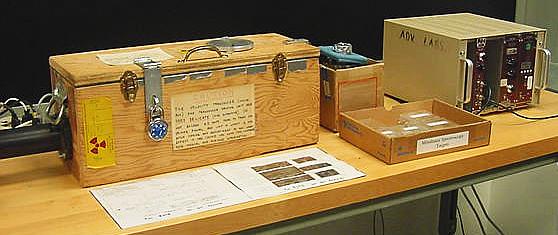Physics 431
Condensed Matter Laboratory
Condensed Matter Laboratory
Mossbauer Spectroscopy of Iron
|

|
In this experiment students are introduced to the beautiful physics of the Mossbauer effect which allows for energy resolutions of ~ a part in 10^(13). The effect is used to measure the intrinsic magnetic field inside iron crystals and to measure the nuclear quadrupole splitting in crystals with electric field gradients at sites of iron nuclei. The effect is also used to measure the subtle "chemical" shift due to the different electronic environments of the iron nuclei in the source and absorber. Finally, relativistic effects can be observed by cooling the absorber to the temperature of liquid nitrogen, 77K, with the source remaining at room temperature. Cooling the absorber relative to the source causes radiation from the source to be red shifted as observed by the absorber, thus changing the amount of first order Doppler shift needed to observe a particular resonance. |

|

|
Experiment Information
- Write-up
- LabVIEW program for analyzing data taken with the Norland MCA. This program is an executable which should run under Windows XP or 2000 without having LabVIEW installed. You must have a copy of the LabVIEW "runtime" program, however, which may be downloaded from the LabVIEW vendor's site: www.ni.com
Discussion Questions
- Describe what would happen to the data set for enriched iron if each of the following changes in the setup were made, assuming that all other settings remain the same (discuss any three).
- The gain on the pulse height amplifier (Ortec 575A) is increased.
- The high voltage bias on the detector is changed from +1800V to +1500V.
- The lower-level discriminator is reduced to zero.
- The MCS dwell time is changed from 500 microseconds to 250 microseconds.
- The phase setting on the function generator is changed from -090 to 000.
Background Information
- Grant, R. W., R. M. Housley, and U. Gonser, "Nuclear electric field gradient and mean square displacement of the iron sites in sodium nitroprusside", Phys. Rev., 178, 523-530 (1969).
- Preston, R. S., S. S. Hanna, and J. Heberle, "Mossbauer effect in metallic iron", Phys. Rev., 128, 2207-2218, (1962).
- Ludwig, G. W., and H. H. Woodbury, "Magnetic moment of Fe-57", Phys. Rev., 117, 1286-1287 (1960).
- Kistner, O. C., and A. W. Sunyar, "Evidence for quadrupole interaction of Fe-57m, and influence of chemical binding on nuclear gamma-ray energy", Phys. Rev. Lett., 4, 412-415 (1960).
- DeBenedetti, S., G. Lang, and R. Ingalls, "Electric quadrupole splitting and the nuclear volume effect in the ions of Fe-57", Phys. Rev. Lett., 6, 60-62, (1961).
- Pound, R. V. and G. A. Rebka, "Variation with temperature of the energy of recoil-free gamme rays from solids", Phys. Rev. Lett., 4, 274-275 (1960).
- Lustig, H., "The Mossbauer effect", Am. J. Phys., 29, 1-18 (1961).
- Vandegrift, G, and B. Fultz, "The Mossbauer effect explained", Am. J. Phys., 66, 593-596 (1998).
- MIT Physics Department, "Mossbauer Spectroscopy" (Lab write-up).
- Harvard Physics Department, "The Mossbauer Effect" (Lab write-up).
Last modified: 10/08/2008 12:14 PM

